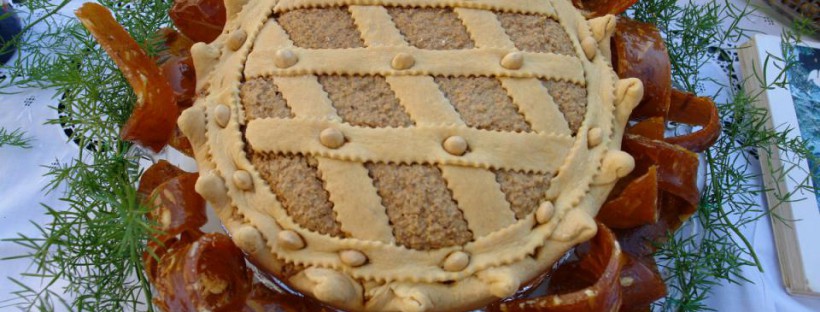The special taste of Hvar paprenjak (gingerbread) was not forgotten mention even by Hektorović in his ‘Fishing and Fishermen’s Objections” and the Brač cake hrapoćuša became a Hvar cultural heritage.
What sweet trick is concealed behind the Hvar cake known from the Renaissance period as paprenjak (gingerbread)? It bears the allusion of pepper but once you try it you feel the sweetness, a special flavour which even Hektorović had not forgotten to mention in his‘Fishing and Fishermen’s Objections”. It comes from saffron, a highly esteemed spice, which, and here is another curiosity of the Island of the Sun, grows here as a wild plant. Paprenjak, the gingerbread from Stari Grad has now become an impressive Hvar souvenir. Pulled out of possible oblivion, it has become a brand product, and has been added to the list of Dalmatian permanent cakes which modern tourists take home with them as an edible souvenir.
Cake reminding of stone
What paprenjak means for Hvar, the hrapoćuša cake means for the island of Brač. This exceptionally nutritive sweet is made according to the original and traditional recipe of the women from Dol which is secretly transferred from generation to generation. Concerning its being nutritive, the best proof is 14 eggs and a bit less than one kilogram of nuts. The inhabitants of Dol decided to protect this calorie bomb, the result of which long project is having it been included in the group of Croatian cultural goods.
– Dol was built on rock called je hrapoćuša, particular and unique. In its honour our ancestors made a cake which shape reminds of that stone, rock which our small locality is made up of – the locals of Dol tell us with unconcealed pride.
We still have some aces up our sleeve, more protected goods, sweets that few can resist. For example, the very famous rafioli from Trogir(special pastry filled with ground almonds) which the woman here make according to patiently preserved recipes, and each one adding her own special supplement, always wishing theirs to be the best and awarded with the title of best rafioli at some gastronomy competition. Then there is the well-known Imotski cake which emperor Francis Joseph himself tasted back in 1875 when he visited Imotski and stayed in the Mazzi House.
It was recorded then in Imotski that the housewives had made a cake of special shape for the event and it resembled a crown. They achieved this by adding horn shapes and peeled almonds that gave the impression of crown jewels. The emperor liked the cake so much that he later received it regularly for his birthday.
– Besides other ingredients, the Imotski cake is made with lard, prosecco, one kilo of almonds, the juice and peels of three oranges, maraschino, nutmeg… there is work there, particularly in the decorations but it is worth the effort for it is truly particular. Its colour also adorns it for it is as light as the moonlight– the Imotski housewives tell us.
A sweet from Venetian government times
More to the south, along the coast, in the Makarska region, a cake has been preserved and it is not cut in triangle pieces but in proper rhombuses. It is the famous Makarska cake, a particularly popular sweet which one has the opportunity of tasting in some of the town pastry shops. It is also protected, named intangible cultural heritagethanks to the work of the team who worked for several years to acquire the status.
– We collected materials for years, documents, proof that it came from this region and was traditionally prepared among the inhabitants that lived here. The basis of the Makarska recipe derives from Venetian government times which means several centuries old. It has succeeded in being preserved so that to this day it can be tasted in this region and offered in the local gastronomy facilities – Ana Kunac, higher curator in Makarska Town Museum, tells us.
Makaranais a real energy bomb whose contents unite a good quantity of almonds, sugar and eggs. And the “culprits” for that special flavour are rose grappa, orange peel and some others which are the little secrets of the great female masters of the cuisine.
– We still have another interesting fact about our makaranacake whereby we have stored the original recipe and documents in the treasury of Zagrebačkabanka. And when it is opened one hundred years from now, the maskaraka cake will be among the fundus being preserved for generations to come –Ana Kunac tells us.
MAKARANA (MAKARSKA) CAKE RECIPE
Sponge cake:
– 3 eggs
– 30 g sugar
– 200 g sweet flour
– 1/2 butter
– one decilitre warm water
Cream:
– 8 eggs
– 1/2 kg sugar powder
– a pinch of mixed spices for cakes
– 1/2 kg ground almonds
– 100 g ground nuts
Prepare the dough for the sponge cake a day earlier and keep it in the refrigerator until preparation. It can stay there for a couple of days. The preparation consists of mixing eggs and flour and slowly adding the remaining ingredients. Spread it and cut off a small part and make mould length bands, about 1,5 cm wide which will be placed on top of the cake, after having added the dressing. Fill the bottom of the mould with the remaining dough and raise it slightly along the sides. Prepare the stuffing so as to foam whisk the eggs and powder sugar. Then slowly add the remaining ingredients and unite them well. Pour the stuffing over the dough and put the prepared bands on top and optionally blanched almonds. Bake at 125 degrees for one hour and fifteen minutes.




